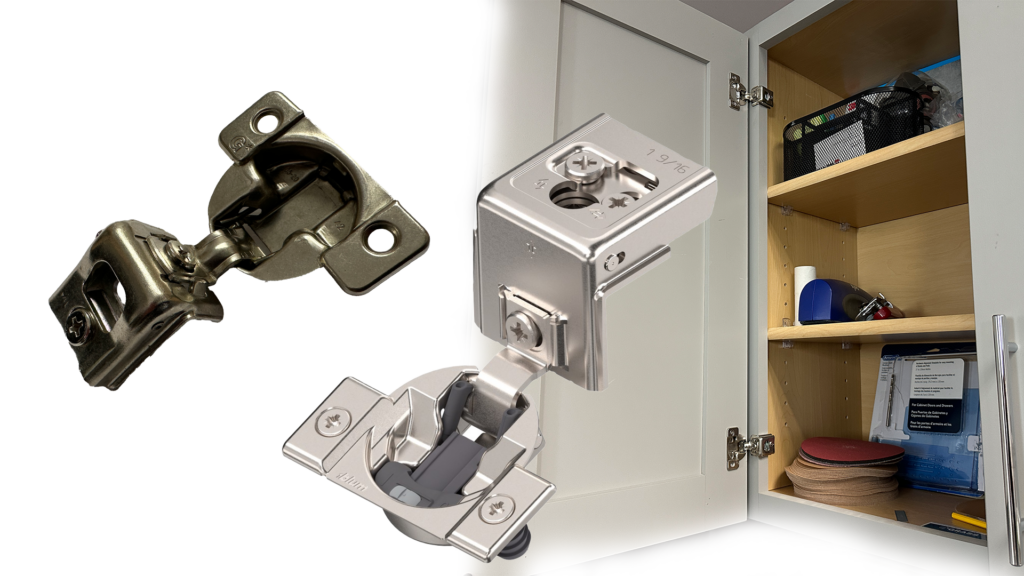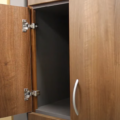Have you ever wondered how modern cabinets look so sleek and seamless? The secret lies in concealed cabinet hinges! These clever devices have changed the functional aesthetic for woodworkers, homeowners, and cabinet makers alike. Why are concealed hinges the top choice for cabinets today? Let’s find out!
What Are Concealed Cabinet Hinges?
Concealed cabinet hinges, also called hidden or European hinges, are the cornerstone of modern cabinetry. Unlike old-style hinges that you can see from the outside, concealed hinges hide inside the cabinet. This gives your doors a clean, smooth look.
Why Choose Concealed Hinges?
Concealed hinges offer several great benefits:
- They look fantastic, giving cabinets a modern, streamlined appearance.
- You can adjust them easily, making it simple to line up doors perfectly.
- They come in different styles to fit various cabinet types.
- Many offer soft-close features for quiet, gentle shutting.
- They’re strong and long-lasting, perfect for busy households or offices.

Types of Concealed Hinges
Two main types of concealed hinges include long arm concealed hinges and compact concealed hinges.
Long Arm Concealed Hinges: These versatile hinges work well with both frameless and face frame cabinets. They have two main parts: the hinge itself and a base plate. This design allows for lots of adjustability and different overlay options. Concealed long arm hinges are great for most cabinet projects.
Key features of concealed long arm hinges include:
- Wide range of overlay options
- High adjustability
- Work with both frameless and face frame cabinets
- Available in various opening angles (90 to 170 degrees)
- Options for special uses (like glass doors or corner cabinets)
Compact Concealed Hinges: These hinges are made specifically for face frame cabinets. They’re smaller than long arm hinges but still offer good adjustability. Compact concealed hinges usually come in one piece, which can make installation simpler.
Key features of compact concealed hinges include:
- Designed for face frame cabinets
- Variety of overlay options
- Compact design for tight spaces
- One-piece construction (usually)
- Limited opening angles (typically 105 to 110 degrees)
Cabinet Types and Hinge Selection
Understanding your cabinet type is key to picking the right concealed hinges.
Frameless Cabinets: These modern cabinets don’t have a frame on the front. The cabinet box itself forms the front edge. Concealed long arm hinges are ideal for frameless cabinets, offering full adjustability and clean lines.
Face Frame Cabinets: Traditional cabinets with a frame on the front can use either long arm or compact concealed hinges. Your choice might depend on the look you want, how much adjustment you need, and the specific cabinet design.

Parts and Features of Concealed Hinges
Let’s break down the key parts and features of concealed hinges:
- Hinge Cup: This part sits in the drilled hole on the cabinet door. Standard cup sizes are 35mm or 40mm.
- Base Plate: This attaches to the cabinet and holds the hinge arm. It comes in various thicknesses to achieve different overlays.
- Arm: This connects the cup to the base plate and determines how far the hinge opens.
- Overlay Options:
- Full Overlay: The door completely covers the cabinet face
- Half Overlay: The door partially covers the cabinet face
- Inset: The door sits inside the cabinet opening
- Opening Angles: Concealed door hinges come in various opening angles, usually from 90 to 170 degrees.
- Closing Types:
- Free Swing: The door moves freely
- Self-Closing: The door closes automatically when nearly shut
- Soft-Closing: The door closes slowly and quietly, preventing slamming
Technical Details to Know
When choosing concealed hinges, pay attention to these details:
- Cup Size: Most often 35mm, but some hinges use 40mm cups.
- Screw Hole Spread: Usually 45mm for 35mm cups, but can vary. Always check before buying.
- Tab Distance: The space from the edge of the door to where the hinge cup starts. Typically 3-5mm, but can affect the final overlay.
- Base Plate Thickness: Ranges from 0mm to 30mm or more. Affects the final overlay and can help fine-tune door position.

Installing Concealed Hinges
Installing concealed cabinet hinges might seem tricky, but with the right tools and know-how, it’s quite doable. Here’s a basic guide:
Tools You’ll Need:
- Drill
- Forstner bit (usually 35mm)
- Hinge jig (optional but helpful)
- Screwdriver
- Pencil for marking
- Tape measure
Steps:
- Mark where you want the hinges on the door (usually 2-4 inches from top and bottom)
- Use your Forstner bit to drill holes for the hinge cups
- Attach the hinges to the door
- Mount the base plates on the cabinet
- Clip the door onto the base plates
Mounting Methods:
- Screw-On: Simply screw the hinge into pre-drilled holes
- Press-In: Use special tools to press hinges with dowels into the door
- Expanding Dowel: Dowels expand when screwed in, securing the hinge
- Tool-Free: Hinges clip into pre-drilled holes without tools
Adjusting Your Hinges
One of the best things about concealed hinges is how adjustable they are. Most offer three-way adjustment:
- Up and Down: Aligns the top and bottom of the door with the cabinet
- Side to Side: Ensures even gaps between doors
- In and Out: Adjusts how far the door sits from the cabinet face
Make small adjustments and check the door alignment until it’s perfect. It might take some patience, but the result is worth it!
Choosing the Right Concealed Hinge
When picking concealed hinges, think about:
- Cabinet type (frameless or face frame)
- Door size and weight
- Desired overlay
- Opening angle needed
- Closing type preference
- Brand quality
- Your budget
Common uses for concealed hinges include:
- Kitchen cabinets
- Bathroom vanities
- Built-in wardrobes
- Office furniture
- Entertainment centers
Caring for Your Hinges
To keep your concealed hinges working smoothly:
- Clean them often with a dry cloth
- Oil moving parts now and then with silicone spray
- Tighten screws if doors get misaligned
- Replace worn hinges to prevent cabinet damage
Common issues and fixes:
- Door not closing right: Adjust hinge or check for things in the way
- Squeaking: Apply oil to moving parts
- Door sagging: Tighten hinge screws or adjust up-down alignment
Transforming Cabinet with Concealed Hinges
Concealed cabinet hinges have truly transformed modern cabinetry. They offer a clean look, great adjustability, and smooth operation. Concealed hinges are important for making cabinets that work well, whether you’re new to DIY or experienced.
Knowing about concealed hinges can help you create nice cabinets. Understanding how concealed hinges work is beneficial. This knowledge can improve the functionality and appearance of your cabinets.
Remember, the right concealed hinge can make all the difference in your cabinet project. Take your time to choose the best option for your needs, and don’t be afraid to ask for help if you’re not sure. With the right concealed hinges, your cabinets will not only look great but work smoothly for years to come!
Now that you know all about concealed hinges, you’re ready to tackle your next cabinet project with confidence. Happy building!



